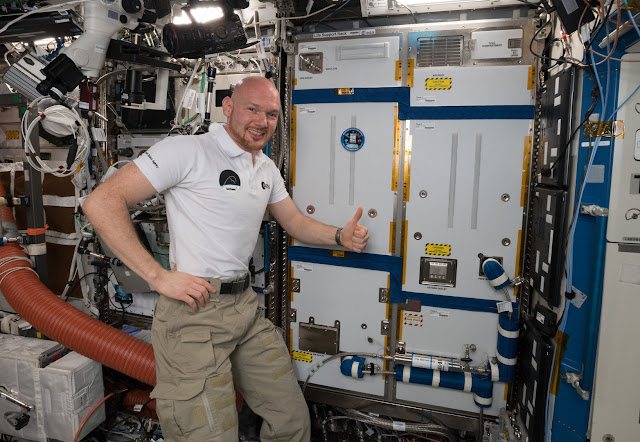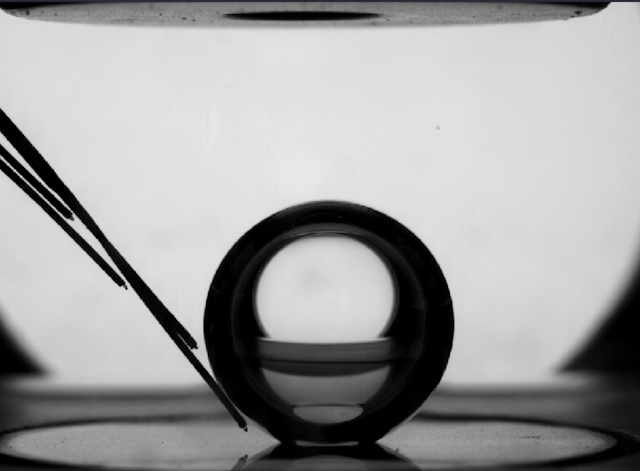ISS - International Space Station logo.
Dec. 10, 2019
In October the International Space Station was even more busy than usual with nine astronauts living and working in humankind’s outpost in Earth orbit. With three more astronauts, the Station’s life support systems worked overtime to provide enough air and water recycling for the crew, and ESA’s new Advanced Closed Loop System (ACLS) stepped in to help scrub the extra carbon dioxide in the air.
A flock of astronauts
The Station is designed to house six astronauts but regularly receives additional visitors for brief periods of time. The extra humans need extra food, water and oxygen, but also create extra waste such as carbon dioxide exhaled from the lungs which puts extra strain on the Station’s life support systems.
n October 2018, ESA launched a new regenerative life support system made by Airbus in Friedrichshafen, Germany. The ACLS is capable of recycling carbon dioxide. Three major steps in the recycling process are currently being tested and worked on in order.
Advanced Close Loop System infographics
One element of the system takes water and separates it into oxygen and hydrogen. A second part captures carbon dioxide from the air and keeps carbon dioxide within acceptable levels using a unique amine process developed by ESA. The recycling step takes place in a ‘Sabatier reactor’. Hydrogen and carbon dioxide react with steam and pass over a catalyst to form water and methane.
The water is condensed to be recycled into oxygen and hydrogen while the methane is vented into space, together with excess carbon dioxide. The element that captures and concentrates carbon dioxide in the three-step system was used extensively when ESA astronaut Luca Parmitano and his six crewmates were joined by three additional astronauts for a few days, boosting existing carbon dioxide scrubbing systems.
Life support rack installed
Though regulating carbon dioxide is only one feature of the ACLS, testing on the Space Station has proven its ability to control CO2 concentrations. The technology used in ACLS is especially suitable for operation at low carbon dioxide levels. This is a major goal for long duration missions in order to increase crew health and comfort.
Full house on the Space Station
“We are very happy to have contributed to Space Station life support operations, especially in such a critical area as the air astronauts breathe,” says Johannes Witt, project manager at ESA, “it is an amazing feeling for the team to consider that the work we invested over years into ACLS is now helping to produce clean air for astronauts in space.”
Table for nine
The system will continue to be tested step-by-step, as some teething problems encountered along the way mean that it is not yet fully operational.
“We knew that designing and testing a life-support system that is the size of a single bed would be a challenge,” explains Johannes.
Space bubble
“Systems with fluids and gases behave differently in microgravity. Air bubbles and particles in the condensate which is used by ACLS posed a much bigger challenge than expected. This is exactly why we developed and are testing the life support system close to home on the International Space Station where problems can be solved relatively easily. Farther away from Earth you need high reliability because repairs are much more difficult.”
The European technology behind the ACLS will be hugely beneficial in exploring farther beyond our planet and engineers, astronauts and ground control are rigorously working on getting the system fully operational.
Advanced Close Loop System life support rack
New parts and filters arrived by cargo ferry and the team is optimistic that the system will be fully operational by early 2020.
Related links:
Human and Robotic Exploration: http://www.esa.int/Science_Exploration/Human_and_Robotic_Exploration
Science & Exploration: http://www.esa.int/Science_Exploration
International Space Station (ISS): http://www.esa.int/Science_Exploration/Human_and_Robotic_Exploration/International_Space_Station
Aniation, Images, Text, Credits: ESA / NASA.
Greetings, Orbiter.ch








